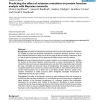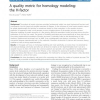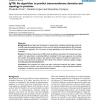258 search results - page 20 / 52 » Multiobjectivizing the HP Model for Protein Structure Predic... |
BMCBI
2006
13 years 7 months ago
2006
Background: A number of methods that use both protein structural and evolutionary information are available to predict the functional consequences of missense mutations. However, ...
BMCBI
2011
13 years 2 months ago
2011
Background: The analysis of protein structures provides fundamental insight into most biochemical functions and consequently into the cause and possible treatment of diseases. As ...
ISVC
2007
Springer
14 years 1 months ago
2007
Springer
Abstract. The function of a protein is dependent on whether and how it can interact with various ligands. Therefore, an accurate prediction of protein-ligand interactions is paramo...
BMCBI
2008
13 years 7 months ago
2008
Background: Due to their role of receptors or transporters, membrane proteins play a key role in many important biological functions. In our work we used Grammatical Inference (GI...
JCB
2006
13 years 7 months ago
2006
Protein fold recognition is an important step towards understanding protein three-dimensional structures and their functions. A conditional graphical model, i.e., segmentation con...



